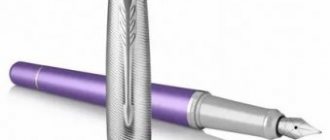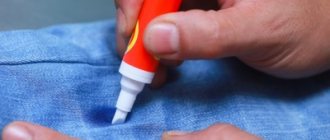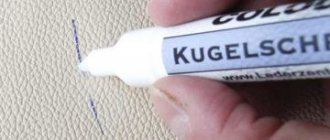There are just brands in the world, but there are legends that make dreams come true. “Ferrari”, “Chanel”, “Tiffany” - all this is the personification of elitism, the special philosophy of “Dolce Vita”. Now name the pens that you will put in this magnificent row... That's right, it's “Parker” - and there can be no other opinions.
Even though other luxury brands are creating writing instruments worth millions of dollars, the leader still remains out of reach. “Parker” is a symbol of exclusivity and belonging to the highest strata of society. Even though the famous manufacturer has fairly affordable ball-type models, this is more of a concession to mere mortals who want to purchase a high-status accessory at an affordable price.
Parker Jotter Premium ballpoint pen (go to SUNLIGHT catalogue)
A short excursion into history
Who would have thought that the first analogues of modern fountain pens appeared around 600 AD? e. However, they acquired a metal body only in 1803. In turn, the first pens with metal nibs appeared closer to the beginning of 1830. However, such office supplies had an extremely short service life.
Shortly before the modern Parker fountain pen was introduced, many manufacturers began producing nibs made from rhodium, osmium, iridium, and also gold (meaning 14- and 17-carat). This approach made it possible to increase the service life of the tips on the handles and marked the beginning of a new mass production.
What is Parker
The history of the Parker brand began at the end of the last century in the USA. The company with a great future was founded by George Safford Parker, a native of Wisconsin. He was born in troubled times: 1863, the Civil War, a reassessment of the values of society, the collapse of hopes and “old” states.
The future multimillionaire was not at a loss - he had to survive. Already at the age of 17, he began teaching at the Janesville Telegraph School (one of Parker's enterprises was later opened there).
The meager salary was sorely lacking, and the young teacher began working as a traveling salesman selling writing instruments. The main clients of the newly minted pen dealer were his students and acquaintances.
There were no ballpoint pens at that time, and fountain pens were not of high quality: they leaked, became clogged, and broke. Customers complained, and Parker felt it was his duty to repair the defective product. This was the impetus for the formation of the Great American Dream specifically for him: Parker set out to create an ideal pen, free of flaws.
George Safford Parker
The first production of pens was organized by an enterprising American in 1888, and a year later George patented his first own model. However, the Parker Pen Company was registered only in 1892, from which its victorious ascent began.
George Parker was a truly talented engineer and creative inventor, not without a keen commercial sense.
The history of Parker is legendary. It was created by brand promotion specialists, so compliance with the truth is their responsibility. We are based on the official version.
Let’s briefly go over the main historical milestones of the initial stage of the company’s formation:
- 1894 – patent for the Lucky Curve feeder, which prevented ink from flowing out of the pen in a vertical position;
- 1905 - invention of the Button Filling System, which replaced the pipette common at that time;
- 1908 - Parker's company becomes the largest pen manufacturer in the world;
- 1912 - invention of the double Safety Cap, which virtually eliminates the risk of ink leakage;
- 1916 – development of a proprietary clamp that is still used today.
Arthur Conan Doyle, the literary father of the famous Sherlock Holmes, was in love with Parker pens and wrote only with them. One of the first “Parkers”, Giacomo Puccini wrote the brilliant opera “La Bohème”.
Parker pens became more and more popular, triumphantly marching around the world. Despite the rather high price, they sold millions of copies, and the public demanded more! George's son, Russell, joined the management of the company, which made it possible to further expand the sphere of influence of the pen giant.
Even the death of George Parker in 1937 did not interrupt the triumphant ascent of his pens. They have become symbols of high status and solidity, an uncompromising embodiment of quality and refined taste. In total, during the existence of the brand, about 70 diverse collections were released, the most successful of which are still in production.
Now the Parker brand belongs to the American giant Newell Rubbermaid. The historic plant in the USA is, unfortunately, already closed. The main countries producing Parker pens at the moment are France and China.
Video material
A Parker pen or any other ink-based pen is far from being a writing instrument; rather, it is a stylish accessory for a business person. Parker ink remains saturated for a very long time and is absorbed into the paper instantly. They do not spread on the paper and correspond to the design of the pen in terms of thickness. Use your writing accessory with pleasure, and we’ve told you how to refill it with ink. Use our tips and recommendations, and your fountain pen will serve you for decades!
Analogues of Parker pens
Many brands produce analogues of Parker, but, of course, somewhat modified, so as not to be suspected of copyright infringement. The Chinese, of course, are not like that: they produce complete analogues of Parker a lot and with pleasure.
If you intend to purchase “Parker” from an unlicensed Chinese bottling, you should not fall into extreme stinginess and buy a noname for 1-2 dollars. Take Jinhao for example: this company has very good replicas of the most successful Parker lines.
Now many are talking about the decline of the former glory of the world pen giant. Yes, the change of owner and the transfer of part of the production to the Middle Kingdom speaks volumes. But, be that as it may, “Parker” will always remain a legend and a pen for the elite!
30.06.21
Rules for using a fountain pen
The writing accessory will serve you for a long time and will delight you with its work if you adhere to the following rules:
- Periodically clean the pen - rinse through the converter. First, you need to fill the reservoir with filtered or distilled water and then rinse it. This manipulation is carried out until the liquid is clean.
- If there is a cartridge in the pen, it must be disconnected before washing. Take a glass of clean water and place the base of the pen here for 40-60 minutes. The water should completely cover the feather. After these steps, wipe the pen with a napkin. Never use alcohol-containing solutions or solvents, or hot water to wash your pen.
- Rinse the pen every two weeks or if you change the ink color in the pen.
Experts give the following recommendations on how to use an ink pen:
- To avoid damaging the pen, do not press hard on the pen when writing. The slight glide of the pen on the paper indicates the quality of this writing instrument.
- It is not recommended to use ink that is a year old. The product must be extremely fresh.
- Make sure there is no sediment, clots or residue in an ink bottle that has not been used for a long time. Only then use it.
- The ink inside the pen should not dry out, otherwise it will lead to irreparable consequences. Gum arabic, which is part of the ink, has adhesive properties. Damage may be permanent if the ink dries inside the nib.
- An accessory that you are not going to use for more than a couple of days must be washed. More precisely, his pen. This will prevent the ink from drying out.
- To prevent fading and drying out, keep the filler out of direct sunlight.
- The glossy surface does not absorb ink. Therefore it is not suitable for a fountain pen.
How to fill and sign?
A fountain pen can be refilled in several ways. Let's take a closer look at the refueling options, taking into account the design features.
Method 1
If you have a piston converter, then disassemble the pen, tilt the refill towards the ink and rotate the piston counterclockwise. Then dip the pen in the ink and scroll the device clockwise. This will allow the ink to be absorbed into the container. Then, without sticking out the pen, unscrew the piston cap slightly until a drop of ink appears from the pen. This must be done to bleed out excess air. Then screw the structure and wipe the handle with a dry cloth.
Method 2
The piston filler functions similarly to the converter. Disassemble the handle and turn the filler counterclockwise. Dip into the ink and make a reverse turn to pump in the liquid. Release the air and assemble the structure.
Method 3
The cartridge system option is the simplest. Disassemble the pen and remove the used cartridge from it. Insert the new system until it clicks and paint the pen until the ink appears.
Why are Parker pens so expensive?
The cost of the most expensive Parker pens from the serial lines exceeds 40,000 rubles. But this is not the limit: there are limited editions with a limited number of copies with unique numbers - this is a real exclusive!
As a rule, limited editions are included in the Parker premium lines. For example, as part of the immortal Duofold, limited editions of “The Craft of Traveling” and Senior are currently being released, costing over 200 thousand rubles. And the incredible Parker Duofold Solid Gold made of gold with the finest engraving (handmade, of course) costs exactly a million of our money!
Parker Duofold Solid Gold
Yes, this manufacturer also has fairly budget models that are quite affordable for “mere mortals”: the same mass-produced “Jotters” at the time of writing cost around 1,200-2,600 (not cheap for a pen, but this is a “Parker”!) However, any Parker pen differs from its “ordinary” counterparts in its truly unsurpassed quality. And the big name cannot be discounted!
Parker pens have made a tremendous contribution to the world. They signed acts of surrender of Nazi Germany and Japan, documents that put an end to the wars in Korea and Vietnam, and many epoch-making agreements between the leaders of the USA and the USSR (later Russia).
How to distinguish an original from a fake?
Like any other expensive item, Parkers are counterfeited with varying degrees of care: some fakes are practically indistinguishable from the originals, others are made so clumsily that the falsification will catch the eye of even a schoolchild.
So, how can you tell an original Parker from a fake? First of all, look at the package. The pens are supplied in branded cases and bags (don’t be lazy to go to the manufacturer’s website and look at the branded packaging). Additionally, a guarantee is provided with instructions and consumables (cartridge or rod). At the moment, the warranty period is 2 years.
Pay attention to the price. A difference of 5-10% from different sellers is normal, but an offer at a price half the usual price should be alarming.
Consider the engraving. You can also distinguish a fake by the quality of the engraving or print. It’s easiest with fountain pens: it’s almost impossible to fake the engraving on the nib in a filigree manner: it must be clear, without flaws.
Take a closer look at the pen. The signature Parker nib is ideal in shape and has no microcracks, bends or other defects. In addition to the mark, the gold nib will also have a hallmark.
Check the cap. All branded pens, regardless of type, are equipped with caps and, as a rule, recognizable arrow-shaped clips. The cap should not dangle: it fits tightly, with a click. The clip is pressed out with force and immediately returns to its original position.
Test the mechanisms. Ballpoint and rollerball pens are equipped with refill feed mechanisms. In most cases, it is rotating (the rod is fed when turned, with a click of the closer) or push-button (with progressive feed). The mechanisms must work clearly. When disassembling, the spring does not fall out of the handle - it is fixed inside.
Try writing. Pens from a renowned manufacturer write softly and evenly, no effort required.
Don't buy expensive things from dubious places. When purchasing, always ask for a receipt so that if something happens you can return the defective product.
How to use a refueling converter
There are several types of converters that differ in their operating methods. Let's look at how the structures work and how to refill them.
Piston rotary converters
The rotary converter is refilled by lowering the pen into the ink and sucking it into the tank using a rotary mechanism.
Piston converters with rod
This type of system resembles a syringe. First, squeeze out the remaining air and liquid from the piston by pressing on the lever. Then we dip the pen into the ink container and pull the piston handle towards ourselves.
Pipette converters
Classic filling system. The ink reservoir is made of rubber, and to fill the ink you need to disconnect the channel from the pen, press on the base of the structure to release excess air, and drop the ink into the can. As soon as you stop squeezing the piston, the desired liquid will flow into the converter.
Built-in piston system
The built-in system has a more complex design, but with it you will not get yourself or your pen dirty. There is a branch from the piston with a small channel. To refill the pen, you need to insert it into the ink container.
Converterless and cartridgeless system
In budget models you can see a simple handle system. It does not have converters or cartridges, and the ink is already filled in the body. Such a mechanism cannot be refilled; ink often leaks out through microcracks in the connections.











